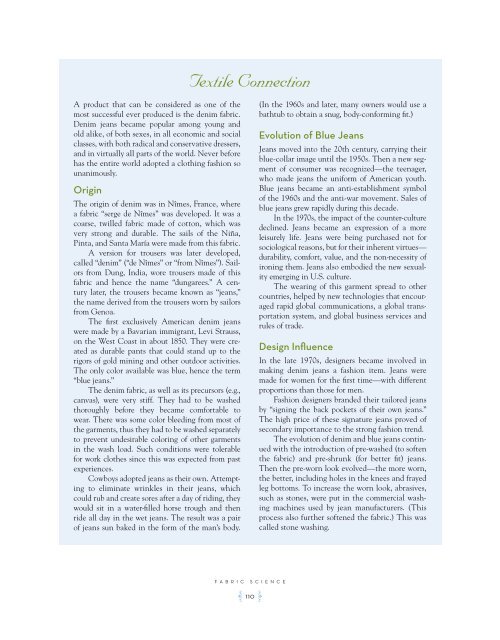You also want an ePaper? Increase the reach of your titles
YUMPU automatically turns print PDFs into web optimized ePapers that Google loves.
A product that can be considered as one of the<br />
most successful ever produced is the denim fabric.<br />
Denim jeans became popular among young and<br />
old alike, of both sexes, in all economic and social<br />
classes, with both radical and conservative dressers,<br />
and in virtually all parts of the world. Never before<br />
has the entire world adopted a clothing fashion so<br />
unanimously.<br />
Origin<br />
The origin of denim was in Nîmes, France, where<br />
a fabric “serge de Nîmes” was developed. It was a<br />
coarse, twilled fabric made of cotton, which was<br />
very strong and durable. The sails of the Niña,<br />
Pinta, and Santa María were made from this fabric.<br />
A version for trousers was later developed,<br />
called “denim” (“de Nîmes” or “from Nîmes”). Sailors<br />
from Dung, India, wore trousers made of this<br />
fabric and hence the name “dungarees.” A century<br />
later, the trousers became known as “jeans,”<br />
the name derived from the trousers worn by sailors<br />
from Genoa.<br />
The first exclusively American denim jeans<br />
were made by a Bavarian immigrant, Levi Strauss,<br />
on the West Coast in about 1850. They were created<br />
as durable pants that could stand up to the<br />
rigors of gold mining and other outdoor activities.<br />
The only color available was blue, hence the term<br />
“blue jeans.”<br />
The denim fabric, as well as its precursors (e.g.,<br />
canvas), were very stiff. They had to be washed<br />
thoroughly before they became comfortable to<br />
wear. There was some color bleeding from most of<br />
the garments, thus they had to be washed separately<br />
to prevent undesirable coloring of other garments<br />
in the wash load. Such conditions were tolerable<br />
for work clothes since this was expected from past<br />
experiences.<br />
Cowboys adopted jeans as their own. Attempting<br />
to eliminate wrinkles in their jeans, which<br />
could rub and create sores after a day of riding, they<br />
would sit in a water-filled horse trough and then<br />
ride all day in the wet jeans. The result was a pair<br />
of jeans sun baked in the form of the man’s body.<br />
Textile Connection<br />
FABRIC SCIENCE<br />
A 110 F<br />
(In the 1960s and later, many owners would use a<br />
bathtub to obtain a snug, body-conforming fit.)<br />
Evolution of Blue Jeans<br />
Jeans moved into the 20th century, carrying their<br />
blue-collar image until the 1950s. Then a new segment<br />
of consumer was recognized—the teenager,<br />
who made jeans the uniform of American youth.<br />
Blue jeans became an anti-establishment symbol<br />
of the 1960s and the anti-war movement. Sales of<br />
blue jeans grew rapidly during this decade.<br />
In the 1970s, the impact of the counter-culture<br />
declined. Jeans became an expression of a more<br />
leisurely life. Jeans were being purchased not for<br />
sociological reasons, but for their inherent virtues—<br />
durability, comfort, value, and the non-necessity of<br />
ironing them. Jeans also embodied the new sexuality<br />
emerging in U.S. culture.<br />
The wearing of this garment spread to other<br />
countries, helped by new technologies that encouraged<br />
rapid global communications, a global transportation<br />
system, and global business services and<br />
rules of trade.<br />
Design Influence<br />
In the late 1970s, designers became involved in<br />
making denim jeans a fashion item. Jeans were<br />
made for women for the first time—with different<br />
proportions than those for men.<br />
Fashion designers branded their tailored jeans<br />
by “signing the back pockets of their own jeans.”<br />
The high price of these signature jeans proved of<br />
secondary importance to the strong fashion trend.<br />
The evolution of denim and blue jeans continued<br />
with the introduction of pre-washed (to soften<br />
the fabric) and pre-shrunk (for better fit) jeans.<br />
Then the pre-worn look evolved—the more worn,<br />
the better, including holes in the knees and frayed<br />
leg bottoms. To increase the worn look, abrasives,<br />
such as stones, were put in the commercial washing<br />
machines used by jean manufacturers. (This<br />
process also further softened the fabric.) This was<br />
called stone washing.













